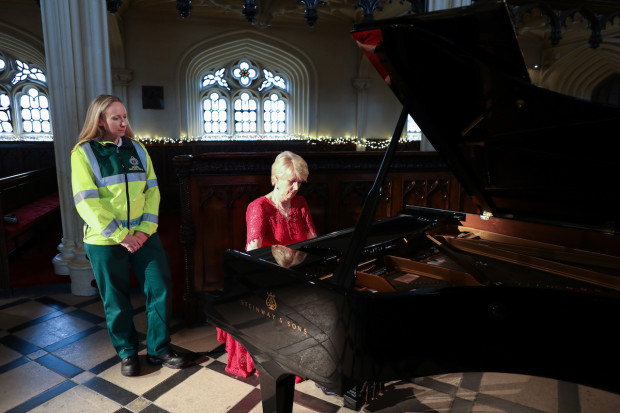
Guitarist Sean Shibe and the Irish Chamber Orchestra (Photo: Dublin International Chamber Music Festival)
Midsummer Reinvention
The Dublin International Chamber Music Festival took place from 17 to 21 June featuring pre-recorded concerts streamed every evening from well-known Irish artists such as Finghin Collins, Elizabeth Hilliard, Robin Tritschler and William Butt as well as a range of international figures. This review will cover the final concert of the festival – entitled ‘A Midsummer Night’s Stream’ – which featured the Irish Chamber Orchestra and guitarist Sean Shibe performing in the palatial surroundings of Castletown House in keeping with the festival’s former incarnation as the Great Music in Irish Houses series.
The concert’s big draw was the world premiere of David Fennessy’s Rosewoods, a piece for guitar and string orchestra. The work is essentially an arrangement of an earlier work, Rosewood (2010) for solo guitar, that was written for Shibe’s teacher Allan Neave and premiered back in 2011. Indeed, it was when this piece was taken up by Shibe himself that Fennessy decided to reinvent the work in a quasi-concertante format after being so impressed with the guitarist’s performances.
The simple pluralisation of the title to Rosewoods reflects the fact that, in terms of material and structure, Rosewoods follows its parent piece Rosewood fairly closely. That said, the addition of the string orchestra does result in a much richer palette of colours and while describing the piece as a concerto would perhaps be a misnomer, the concertante element does introduce interesting results. The strings perform two major functions in the new work; the first is to provide a backing halo at certain points and the second is to takeover completely or double certain lines, resulting alternatively in lively dialogue passages or a more full sound world, even if some listeners may prefer the raw brittleness and delicate resonances of the original.
The opening movement neatly demonstrated these functions beginning with static string harmonics that provided an atmospheric backdrop. From here the guitar introduced a repeated triplet figure that was soon taken over by the orchestra, which entered into an alternating dialogue with brilliant flourishes of fast notes on the guitar. This strategy of short blocks of material with repeated patterns without any larger sense of goal-directedness is only as effective as the material it serves up, but in terms of determining catchy sonorities Fennessy’s ear was characteristically on form.
Another good example was the second movement, which began with a simple ostinato accompanying an ascending and descending whole-tone melody. New notes, prefaced with slides on the guitar and glissandi on the strings, were added to the melody giving an eastern flavour while the ostinato gently ticked away on pizzicato strings. It was all quite simple but rather pleasant and, if it occasionally strayed into atmospheric soundtrack territory, there was always enough inventiveness in the scoring to re-enliven the texture as, for instance, in the penultimate section of the movement, where the ostinato moved down to the cello and basses while the upper strings and guitar produced a more abstract canvas of rasping trills, scratching sounds and random hammer-ons.
While the majority of the piece struck a gently contemplative tone, there were more boisterous moments particularly in the fourth movement that demonstrated Fennessy’s penchant for catchy pulsing textures which utilise the guitar in the manner of a percussion instrument, deploying variations on familiar guitar techniques such as fret tapping and snapping the strings against the freeboard. Throughout all of this, Shibe seemed completely immersed in the performance and flawlessly navigated the piece’s challenges, which were more timbre-based and colouristic rather than simply shredding it up on the guitar. In this piece, as with other recent guitar pieces such as JACK, which featured during this year’s New Music Dublin festival, Fennessy seems to be able to strike a balance between gently innovative material for the instrument and attractive, very accessible textures.
The suite nature of the piece, with each movement portraying a different mood, largely avoiding any overwrought expression, sat well with the other items on the programme and in this sense fitted in with the midsummer night music theme. In the work that opened the concert, Grieg’s Holberg Suite, the ICO did an exemplary job of bringing out the distinctive flashes of lyricism in this exercise in compositional pastiche.
Also in full pastiche mode was Photography by the Belize-born British composer Errollyn Wallen, a work which, even in its slow movements, was characterised by a headlong, free-flowing style of long interweaving melodies containing references from everything to Baroque counterpoint to riffing minimalist patterns. While the piece brought an energetic conclusion to the concert, the slightly chaotic mélange of styles it contained tended to rush into one another rather than provide contrast.
One final point is that while the concert was immaculately produced with excellent sound quality and camerawork, the pre-recorded approach to streaming definitely lacks the ‘live’ element of danger, a residue of which is still preserved in live-streaming. This is not a criticism but more of an observation and it was perhaps the case that the logistics of moving around in such delicate surroundings made the prospect of live-streaming impossible. In any case, huge credit must go to the organisers for delivering another instalment of the Dublin International Chamber Music Festival and an altogether substantial one at that in the midst of such difficult circumstances.
Visit https://dicmf.com/
Published on 24 June 2021
Adrian Smith is Lecturer in Musicology at TU Dublin Conservatoire.

















